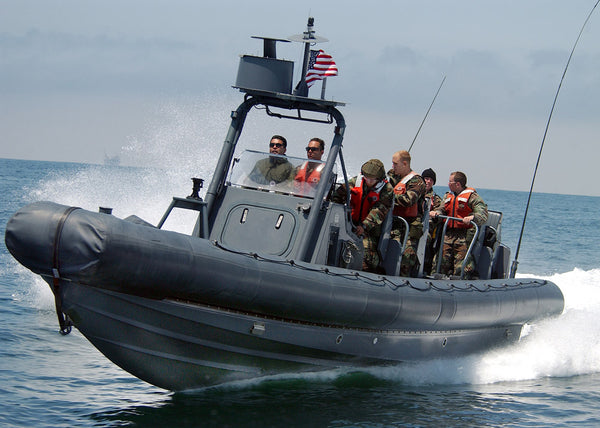DINGHY: INFLATABLE BOATS VS. RIBS
Choosing the “best dinghy” can be incredibly tough with the current surplus of different types and brands available today. When doing your research, keep in mind that the “best dinghy” will vary from person to person, and ultimately, depend on one that suits your personal preference, meets your requirements, fits within your budget and safely gets you to where you need to be - your next adventure on the water!
To help narrow down your options between hard (rigid inflatable boats or RIBs) and standard inflatable boats, this article will cover the merits and drawbacks of both types.
RIGID INFLATABLE BOATS (RIBS)
PROS
Rigid inflatable boats are designed with a solid, contoured V-hull. This is commonly referred to as a “Deep V”. This Deep V boosts the RIBs power and performance in the water by optimizing its directional stability and its capability to rise up and climb towards the surface of the water to get on plane more easily. The sturdy construction of the hull adds extra strength, allowing it to easily cut through waves, rough waters and choppy conditions with little effort. This hull design on a RIB also gives it superior maneuverability and greater top speed while on plane.

CONS
RIBs are much more expensive than inflatable dinghies with inflatable keels, especially if you also consider the maintenance costs and storage fees that will accumulate over time. Since RIBs are heavy and bulky, they cannot be easily carried, launched, brought ashore, and stowed; thus, the need for a trailer to transport them and a larger amount of space for storing them after use.
Rigid inflatable boats might sound more durable because of their wood, steal, or even fiberglass hulls, but this doesn’t exempt them from dings, dents and damage during use or when they become grounded. The outer finish on the fiberglass, or gelcoat, is prone to scratches and deterioration caused by sharp, abrasive contact such as rocks. This can result in spider cracks and blistering, which will eventually lead to the water getting through the gelcoat. When launching or retrieving a fiberglass boat, the sharp edges of a trailer can also damage the gelcoat if one is not careful. If improperly maintained, the resin within the fiberglass is susceptible to deterioration. Repairing this type of damage is extremely expensive. RIBs with aluminum hulls can also become and issue if their hulls become dented or damaged from impact as well, deformation of the hull can affect the performance of the boat.
While Deep V boats have superior performance while on plane, they can be fairly unstable while stationary. These RIBs are taller out of the water, which causes them to tilt more easily when there is movement on the deck. If one is too careless, they might go overboard!

INFLATABLE BOATS
PROS
A great advantage of inflatable boats is that they cost a lot less than a RIB. That doesn’t mean you get less out of it when comparing their reliability and performance. Inflatable dinghies are incredibly versatile and convenient to use in nearly any waterway. In fact, one of the best features that soft dinghies have is their portability. Given its lightweight and soft hull, these dinghies are easier to launch and retrieve compared to rigid inflatable boats.
Inflatable boats can also be deflated and folded into a smaller size with little difficulty. This allows them to fit in small, tight spaces like storage lockers on boats or RVs, closets or even the trunk of your car. On top of that, inflatable boats don’t require the use of trailers. Without having to purchase and store a trailer or paying the extra gas costs that are associated with towing, this will save you a significantly in the long run.
Needless to say, an inflatable boat is cheaper to maintain, as it only requires minimal maintenance after every use (cleaning, draining, and drying). All you need is soap and water, occasional anti-mildew treatment, and a quality fitted cover for protection against exposure to saltwater, accumulated dirt, and bird droppings. If you take proper care of it after every use, your dinghy can last for many years. The minimal cost and work of maintenance will pay for itself by increasing the resale value if you decide to sell your inflatable boat.
Inflatable boats have flexible and wide tubes that provide great buoyancy, making them easy to maneuver and incredibly stable in all sea conditions. Because they ride on the water surface and low center of gravity, they have outstanding stability and are very difficult to flip. No matter where you stand on it, it is unlikely to tip over, or for you to fall out. This makes weight distribution with soft inflatables a lower priority compared to rigid inflatable boats, which can be unstable and rock side to side. Inflatables dinghies also have multiple air chambers, allowing them to remain afloat in the event one of the chambers gets punctured. This makes them incredibly safe for anyone who uses them. If you do get a puncture, they are easy and cheap to fix.

CONS
Soft inflatable boats are much lighter than RIBs and only possess an inflatable keel, which does affect their performance with speed power, maneuverability and load capacity. The inflatable keel doesn’t protrude into the water as far as a fiberglass Deep V Keel, explaining their lower top speed and reduced performance. This is not usually an issue for most users, but could impact the fuel efficiency of the boat.












1 comment
The EGFR mutations in the protein kinase like domain, namely E709K, V774M, and L861Q, were predicted to be damaging, deleterious, and cancer related Table 5 buying cialis online safe
Leave a comment